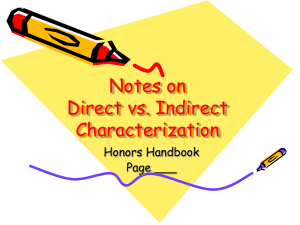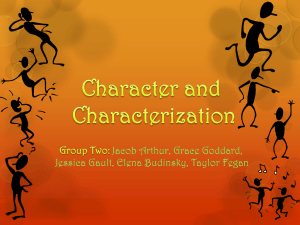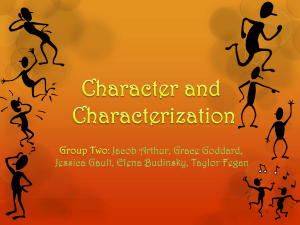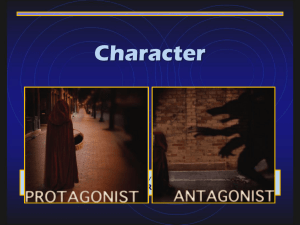MDG Direct and Indirect Characterization
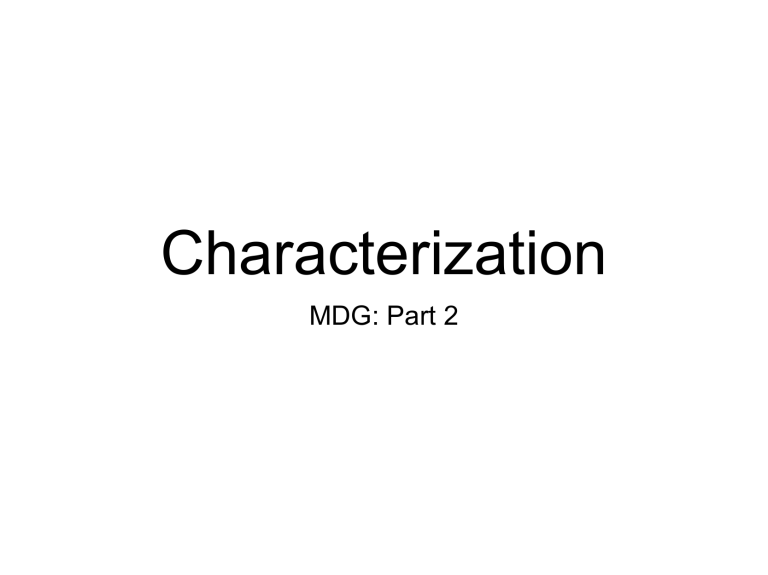
Characterization
MDG: Part 2
Bell Ringer
•
In 3-5 sentences, describe the most important person in your life.
Agenda
•
Bell Ringer
•
Skill focus: Direct/Indirect
Characterization (notes)
•
Post-it note activity
•
Finish reading MDG
•
“Dear Abby” Exit Slip
Common Core Standard
RL.9-10.1
Cite strong and thorough textual evidence to support analysis of what the text says explicitly as well as inferences drawn from the text.
BIG IDEA: CHARACTERIZATION
Direct
Characterization
•
DEFINITION: when an author TELLS us straight up about a character.
•
EXAMPLE: Jessica is a caring and selfless person. .... ( the author TELLS us she is caring and selfless!)
Indirect
•
Characterization
DEFINITION: when an author SHOWS us information about a character so that we (the readers) must make an
INFERENCE
•
EXAMPLE: Jessica volunteers at the homeless shelter every night after school to help those in need... (the author
SHOWS us she is caring and selfless through her actions!)
There are several ways we can find out information about a
•
S character...
- what the person SAYS or the language they use
•
T - what that person THINKS or the beliefs they hold
•
E the person’s EFFECT on others
•
A the person’s ACTIONS ...what they do and how they do it
•
L the person’s LOOKS or appearance
Let’s Practice
On your paper are some passages from famous texts. You must read this and decide if it is
DIRECT or INDIRECT characterization. In other words, decide if the writer is showing (indirect) or telling (direct) us information about the character.
Then determine if it is and example of S, T, E,
A, or L.
The Hobbit J.R.R. Tolkien
All that the unsuspecting Bilbo saw that morning was an old man with a staff. He had a tall pointed blue hat, a long grey cloak, a silver scarf over which his long white beard hung down below his waist, and immense black boots.
Is the author telling or showing?
S? T? E? A? L?
The Hobbit J.R.R. Tolkien
The poor little hobbit sat down in the halo and put his head in his hands, and wondered what had happened and what was going got happen, and whether they would all stay for supper.
Is the author telling or showing?
S? T? E? A? L?
Post-It Practice
•
Each of you should receive TWO post-it notes.
•
Around the room are photos of people
•
You must write a DIRECT characterization on one post-it and an INDIRECT characterization on the other. (Both post-its do NOT have to be for the same photo!!)
•
When you finish, go to the photo(s) and stick the post-its below or around it
•
Then go back to your seat as quickly as possible so we can discuss!
Finish “MDG” pg. 26-34
• Reading questions
– 1. How does Rainsford happen to arrive on the island?
– 2. What does Zaroff say he has become bored with?
– 3. What species has Zaroff now chosen as his prey?
– 4. What are the terms of the game?
– 5. Explain ONE way Rainsford tries to escape or outwit Zaroff.
– 6. How does Rainsford finally escape from Zaroff?
Exit Slip
• On your exit slip handout, we will read the “Dear Abby” letter sample together and discuss. Annotate for direct/indirect characterization!
• Then read “Your Task” and complete the prompt, assuming the persona of either Rainsford or Zaroff.
IF TIME:
• Pass letters out at random so students can respond and give advice, using
DIRECT CHARACTERIZATION
